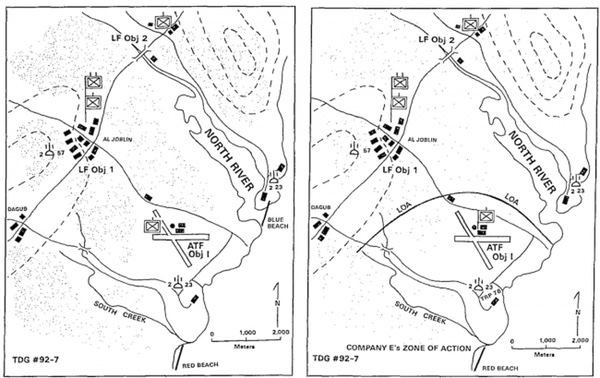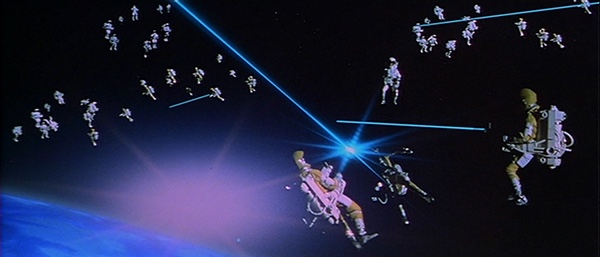Finding Ender: The utility of tactical decision games for space warfareby Joseph T. Page II
|
| While collaboration between space organizations have increased dramatically in the last 16 years since the Space Commission Report, the stove-piping of thought is still run through the traditional military education channels. |
Coram describes the early difficulties these Devil Dog “maneuverists” faced against their own service. However the grassroots adoption of the tenants of maneuver warfare (later codified into FMFM-1, Warfighting) by these young officers spread throughout the Corps and the Defense Department in the following decade. The fruits of the maneuverists’ labor was succinctly described during the assault on Grenada in 1983, via a quote from Gen. John W. Vessey Jr., the Chairman of the Joint Chiefs of Staff:
“We have two companies of Marines running rampant all over the northern half of this island, and three Army regiments pinned down in the southwestern corner, doing nothing. What the hell is going on?”
For space warfighters, a similar grassroots approach has not taken hold. While collaboration between space organizations have increased dramatically in the last 16 years since the Space Commission Report, the stove-piping of thought is still run through the traditional military education channels: Professional Military Education (PME), academia, US Air Force Weapons School, and on-the-job training, to name a few. While these institutions create impressive bodies of knowledge, this experience draws from one unique pool: applicants who are selected to attend.
Journeymen within the ranks—junior officers and enlisted space crewmembers—spend hundreds (and in some cases thousands) of hours working on space systems. Solving technical issues and troubleshooting anomalies are their bread-and-butter, and builds a patina of experience. How can organizations utilize these individuals’ experience, when they may not always rise above the pack for promotion and accolades, leading to choice PME assignments?
Find an inexpensive way to use their gray matter to solve problems facing the space warfighting community.
A thinking person’s game
Two publishing attempts at connecting the space warfighting community within the US military, High Frontier and the Space Tactics Bulletin (STB), fell victim to unknown circumstances and disappeared off the radar. High Frontier went from print publication to on-line only, and ceased publication in 2011, focusing on scholarly articles in other publications.
The STB went from unclassified print publication to classified electronic dissemination and its current status is unknown. STB’s official purpose was stated in each issue:
“[STB’s] purpose is to update warfighting staffs and units on SWC [Space Warfare Center] efforts to effectively employ space assets in support of operations, and provide a forum for information exchange to improve space tactics and procedures.”
While the aims and audience of each were different—STB was at the tactical and operational level, and High Frontier aimed at strategy and policy—the publications gave space-thinking people food for thought about space operations.
One area the publications lacked, in the view of this author, was column for “What Ifs?” at the tactical, operational, and strategic levels. During an early deployment for OIF/OEF in 2004, I ran across the professional journal of the US Marines, the Marine Corps Gazette. Flipping through the pages, I discovered a great critical thinking tool in the form of their Tactical Decision Games (TDGs).
The Gazette’s TDGs were focused tactical problems, ranging from defense of a checkpoint with surrounding collateral interests (e.g. people) to coordinating defense via unencrypted communications in a radiofrequency comms-denied environment. After presentation of the situation (with diagrams and tables of equipment), the requirement gave questions for the Marines to solve. Instead of remaining theoretical or rhetorical, the Gazette gave an email or snail mail address to send solutions to for publication in a future issue.
 Map example from US Marine Corps Tactical Decision Game #92-7. (credit: Marine Corps Association) |
Space T/ODGs
During my time at the Joint Space Operations Center (JSpOC), I witnessed, evaluated, and participated in a few staff and “command post-esque” exercises. During the US Strategic Command (USSTRATCOM) exercises, GLOBAL LIGHTNING and GLOBAL THUNDER, operational level decisions were bandied about as quickly as the three-star general officer could make them. One trend I noticed was dearth of routine operational or strategic-level thought by operations floor personnel. Understandably, their jobs depended more on tactical-level decisions and running checklists for the commander’s campaign success.
Field-grade officers presented information to the colonels and generals, who made command decisions. On the ops floor, it was occasionally the company-grade or non-commissioned officer (NCO) who discovered a key piece of information, or had an epiphany of sorts, that may have driven inconceivable decisions.
The introduction of Space Tactical/Operational Decision Games (T/ODG) will not turn members of the enlisted corps or junior officers into field marshals overnight, nor should it. However, presenting the games in such a way of providing the perspective of a general, combatant commander, or civilian policymaker can increase the synergistic returns during staff, command post, and tabletop exercises, and provide huge dividends during real-world operations.
| On the ops floor, it was occasionally the company-grade or non-commissioned officer (NCO) who discovered a key piece of information, or had an epiphany of sorts, that may have driven inconceivable decisions. |
Presentation of a problem, in the form of an unclassified vignette and requirements, can strike up conversation topics just like the Maneuverists’ meetings at Quantico in the 1980s. The vignettes could range from made-up (i.e. Red vs. Blue), historical (i.e. political fallout from COSMOS 954 re-entry), or quasi-realistic (i.e. commercial company increasing infrastructure and support demands upon civil and military launch infrastructure). Due to the cessation of official publications like High Frontier or STB, dissemination could reside on classified networks, as well as a repository of collected solutions. Contrasting to the unclassified nature of the problem, the results of the T/ODGs should be kept controlled, especially if the problem and TO&E (table of organization and equipment) used are reflected in current reality.
If the leap to classified T/ODGs was desired, coordination with the DoD’s Space Countermeasures Hands-On Program (Space CHOP), and their diverse customer base, could create a realistic game series for company grade officers and junior enlisted to test their mettle against paper adversaries, bureaucratic parameters and the fog of war. Unique or ground-breaking solutions could drive organizations to fund and execute lower fidelity simulations based on the outcomes submitted.
Example of a T/ODG problem
The Space Review’s “An alternative view of the HGS-1 salvage mission” could provide a requisite example for the foundation for a Space T/ODG:
“Situation: Your (company/country/organization) just launched a (notional/specific bus) geosynchronous communications satellite. However the booster rocket provided less (thrust/time) than expected, stranding the satellite in a (inclined/parking) orbit with (unstable attitude/broke thrusters/unfurled antennae). Organizational stakeholders are demanding a solution to the satellite’s missed mission, and the (CEO/General) would like options to consider.”
While the actual answer to the HGS-1 problem resides within the history books, other possible solutions exist, ranging from “doing nothing” (and the political fallout from it), to changing the customer and mission set for providing communications around the Moon. While the possibilities could be endless, pragmatism, along with the decision game requirements, can provide boundaries to solutions.
References
Chapman, Bert. Space Warfare and Defense: A Historical Encyclopedia and Research Guide. ABC-CLIO, 2008.
Coram, Robert. Boyd: The Fighter Pilot Who Changed the Art of War. Hachette Book Group, 2002.
Marine Corps Association. “Marine Corps Gazette: TDG Archives.”
